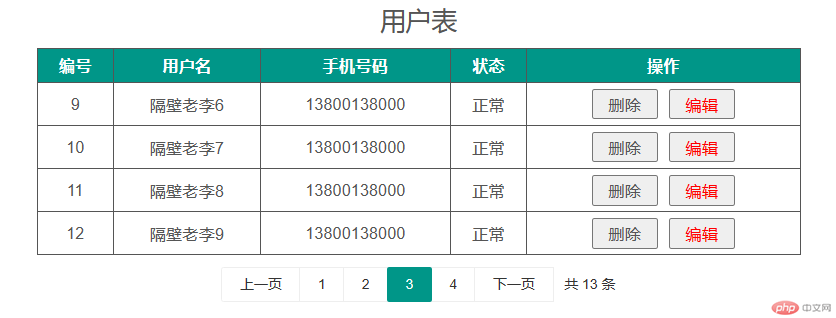一、原生分页
1、pageData.php文件
根据上节课学习内容,使用pdo对数据库进行操作处理,读取具体数据和总条数进行渲染,分页按 总条数 / 每页多少条 得出页码。
/*** 分页 limit子句* pageSize每页获取多绍条数据,当前页page 偏移量* order by 子句存在limit前面*/// 页码来自get参数$page = $_GET['page'] ?? 1;// 越界检测$page = $page<1 ? 1: $page;// 每页显示数量$pageSize = 4;// 偏移量 offset$offset = ($page - 1) * $pageSize;$db = new PDO('mysql:host=localhost;dbname=phpcn22','root','root');$sql = 'select id,uname,status from user limit ?,?;';$stmt = $db->prepare($sql);$stmt->bindParam(1,$offset,PDO::PARAM_INT);$stmt->bindParam(2,$pageSize,PDO::PARAM_INT);$stmt->execute();$users = $stmt->fetchAll(PDO::FETCH_ASSOC);// print_r($users);// 计算总页数// 1. 计算数据表里所有的记录$sql = 'SELECT COUNT(id) AS count FROM user;';$stmt = $db->prepare($sql);$stmt->execute();// 获取总页数方法1 :/* 查询结果里的字段绑定到一个变量上$stmt->bindColumn('count',$total);$stmt->fetch();*/// 获取总页数方法2 :$total = $stmt->fetch()['count'];$pages = ceil( $total / $pageSize );
2、index.php文件
<?phprequire 'pageData.php';?><!DOCTYPE html><html lang="zh-CN"><head><meta charset="UTF-8"><meta http-equiv="X-UA-Compatible" content="IE=edge"><meta name="viewport" content="width=device-width, initial-scale=1.0"><link rel="stylesheet" href="style.css"><title>Document</title></head><body><table border="1"><caption>用户表</caption><thead><tr><th>编号</th><th>用户名</th><th>手机号码</th><th>状态</th><th>操作</th></tr></thead><tbody><?php foreach ($users as $user): ?><tr><td><?= $user['id'] ?></td><td><?= $user['uname'] ?></td><td>13800138000</td><td><?= $user['status'] == 1 ? '正常' : '注销' ?></td><td><button>删除</button><button>编辑</button></td></tr><?php endforeach; ?></tbody></table><p><!-- 动态生成分页 --><?php// 上一页$prev = $page - 1;// if (expr) {expr1}// 系统先判断expr是否为真,如果是,则执行后面的语句,// 如果否,后面的语句就没有执行的必要了;转换成IF语句为if ($page == 1) $prev = 1;if ($page != 1) :?><a href="<?= '?page=' . $prev ?>">上一页</a><?php endif; ?><?php for($i=1; $i<=$pages; $i++) :$active = ($i == $page) ? 'active' : null;?><a href="<?= '?page=' . $i ?>" class="<?= $active ?>"><?= $i ?></a><?php endfor ?><?php// 下一页$next = $page + 1;if ($next == $page) $next = $page;// 当前页码不等于总页面,显示下一页if ($page != $pages) : ?><a href="<?= '?page=' . $next ?>">下一页</a><?php endif; ?></p></body></html>
3、运行结果:

重点是index.php文件的 【动态生成分页】代码:但是一个是混编,一个没有前后端分离,阅读起来有点费劲。
二、layui分页
- 首先登录layui官网下载插件:https://layui.gitee.io/v2/
- 然后进行css、js代码加载;
— <link rel="stylesheet" href="layui/css/layui.css">
— <script src="layui/layui.js"></script> - 具体使用可参考官网文档:https://layui.gitee.io/v2/docs/modules/laypage.html
1、PDO数据库操作不变。
2、index.php文件
<?phprequire 'pageData.php';?><!DOCTYPE html><html lang="zh-CN"><head><meta charset="UTF-8"><meta http-equiv="X-UA-Compatible" content="IE=edge"><meta name="viewport" content="width=device-width, initial-scale=1.0"><link rel="stylesheet" href="style.css"><link rel="stylesheet" href="layui/css/layui.css"><title>Document</title></head><body><table border="1"><caption>用户表</caption><thead><tr><th>编号</th><th>用户名</th><th>手机号码</th><th>状态</th><th>操作</th></tr></thead><tbody><?php foreach ($users as $user): ?><tr><td><?= $user['id'] ?></td><td><?= $user['uname'] ?></td><td>13800138000</td><td><?= $user['status'] == 1 ? '正常' : '注销' ?></td><td><button>删除</button><button>编辑</button></td></tr><?php endforeach; ?></tbody></table><div id="page"></div><script src="layui/layui.js"></script><script>layui.use(['laypage'],function(){var laypage = layui.laypage;//执行一个laypage实例laypage.render({elem: 'page' //注意,这里的 test1 是 ID,不用加 # 号,count: <?= $total ?> //数据总数,从服务端得到,limit: <?= $pageSize ?>,curr: <?= $page ?>,layout: ['prev', 'page', 'next', 'count'],jump: function(obj, first) {// obj包含了当前分页的所有参数,比如://首次不执行if (!first) {window.location.href = '?page=' + obj.curr;}}});});</script>
2、运行结果:

使用layui插件方便快捷,代码易读性良好!
三、MVC架构
MVC框架理解:
- M:model模型,对数据库管理、操作;
- V:view试图,前端视图格式化;
- C:controller控制器,请求派发器,用户点击等事件进行处理。
案例:
1、Medel.php文件
<?php// 模型 数据操作namespace mvc_demo;use PDO;class Model{public function getData(){return (new PDO('mysql:host=localhost;dbname=phpcn22;','root','root'))->query('select id, uname, status from user order by id asc limit 0,5')->fetchAll(PDO::FETCH_ASSOC);}public function editData(){}}
2、View.php文件
<?phpnamespace mvc_demo;class view{public function fetch($data){$table = '<table>';$table .= '<caption>用户信息表</caption>';$table .= '<tr><th>编号</th><th>姓名</th><th>手机号</th><th>状态</th><th>操作</th></tr>';foreach ($data as $user) {$user['status'] = $user['status'] == 1 ? '正常' : '注销';$table .= '<tr>';$table .= '<td>' . $user['id'] . '</td>';$table .= '<td>' . $user['uname'] . '</td>';$table .= '<td>13800138000</td>';$table .= '<td>' . $user['status'] . '</td>';$table .= '<td><button>删除</button><button>编辑</button></td>';$table .= '</tr>';}$table .= '</table>';return $table;}}$data = (new Model)->getData();echo (new View)->fetch($data);
3、Controller.php文件
<?phpnamespace mvc_demo;require 'Model.php';require 'View.php';class Controller{protected $model;protected $view;// 依赖注入其实本质上是指对类的依赖通过构造器完成自动注入// 通过构造方法将外部对象初始化,实现了外部依赖注入的对象在类内部的共享/复用public function __construct(Model $model,View $view){$this->model = $model;$this->view = $view;}// 在控制器架构方法和操作方法中,一旦对参数进行对象类型约束则会自动触发依赖注入// 在操作方法中注入public function index(Model $model,View $view){// 1. 获取数据 Model$data = $this->model->getData();// 2. 视图渲染 View$this->view->fetch($data);}public function edit(Model $model){$this->model->editData();}}$model = new Model;$view = new View;//echo ($new Controller($model,$view))->index($model, $view);$c = new Controller($model,$view);call_user_func_array([$c,'index'],[$model,$view]);
运行结果:

总结:
`Model`:数据库类,对数据库管理、操作;`View`:视图类,对前天视图的格式化;`Controller`:控制器类,请求派发器,对用户事件进行处理- 控制方法,构造方法,调用方法,获取数据`依赖注入`:将模型和视图的实例化过程,放在控制器的外部进行实现,作为参数,注入到控制器的方法中。

